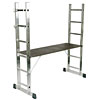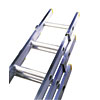The first thing to mention in this project is that there are two reasons for painting external masonry. One is for the decorative effect and the other is to make an unsound surface waterproof. If you are considering decoration for waterproofing, please read our waterproofing external masonry project first.
Any masonry surface, as with any decorated surface, needs to be thoroughly prepared. Absolutely any decorating job is only as good as the preparation work that has gone into it, and paint, liberally and quickly applied, over unclean and unprepared surfaces, will not stand the test of time.
Brush your masonry clean. First with a stiff brush (a household broom is a good tool with its longer handle) Use a soft (brass bristles) wire brush on stubborn spots. It may be necessary to use a brick cleaning acid on really stubborn areas of old cement or existing, flaking paint.
A pressure washer can be used to clean masonry but if you do use one you must wait until your walls are completely dry before you paint. This takes, with continuous sunshine, about 3 weeks so we do not recommend it.
Most masonry paints seal any damp in. This will result in the damp, as it cannot evaporate, turning to mould or trying to find a way into the building via those nice warm inside walls! If masonry is damp it increases the chances of a reaction with the salts contained in the masonry itself or the mortar. This leads to efflorescence (find out more about this in our efflorescence project). Heat loss through damp walls is three times greater than through dry walls.
When the surface is clean, check all the joints for holes. Paint is not a filler and if you have missing pointing, or lumps missing from bricks or blocks you may stand back to admire your work to find you have big black voids staring back at you.
Fill any missing joints with sand and cement mixed at 3 to 1 and push well into the brickwork. This mix can be used to fill holes in bricks blocks and stone also. For greater adhesion to the surface, mix a cupful of PVA adhesive with every bucket or even ½ bucket of mortar you use.
If your masonry has suffered from mould in the past, it is a good idea to treat it with a fungicide wash first. These are widely available from DIY stores and decorators merchants and simply brushed on, left for 24 hours, and washed off. Remember that washing your masonry is not the same as power washing your masonry where water can be forced into and behind your walls.
Painting Brickwork and Other Masonry
Once the joints are filled and the surface is clean you can stabilise the surface. Masonry stabilising solution is also known as primer binder as it not only "primes" (gets ready for what is to come) the surface, but it binds any potentially loose dust spots and invisible, potential flakes together.
It is not magical and it will not hold loose bricks together, but it will provide a more stable surface on which to paint. An added bonus is that it makes your masonry paint go further as it has already primed the surface and made it slightly less absorbent.
Another point to mention here is that most masonry stabilisers will not allow your masonry to breathe. The effects of "suffocating" masonry are mentioned above and are not pleasant, or inexpensive to deal with. Look for a stabiliser which will continue to allow the masonry to breathe. When painting look for microporous paint which, again, allows the mortar to breathe. Your local builders or decorators merchants will give you advice on this and be able to order microporous paints for you. Even better is an anti-mould breathable paint.

Scaffold tower

Extending ladder
Remember to stay safe and tie any ladders you use. Easy to erect scaffold towers can be hired from local tool hire shops and for very difficult areas it is possible to hire a "cherry picker" which is mechanically operated.

